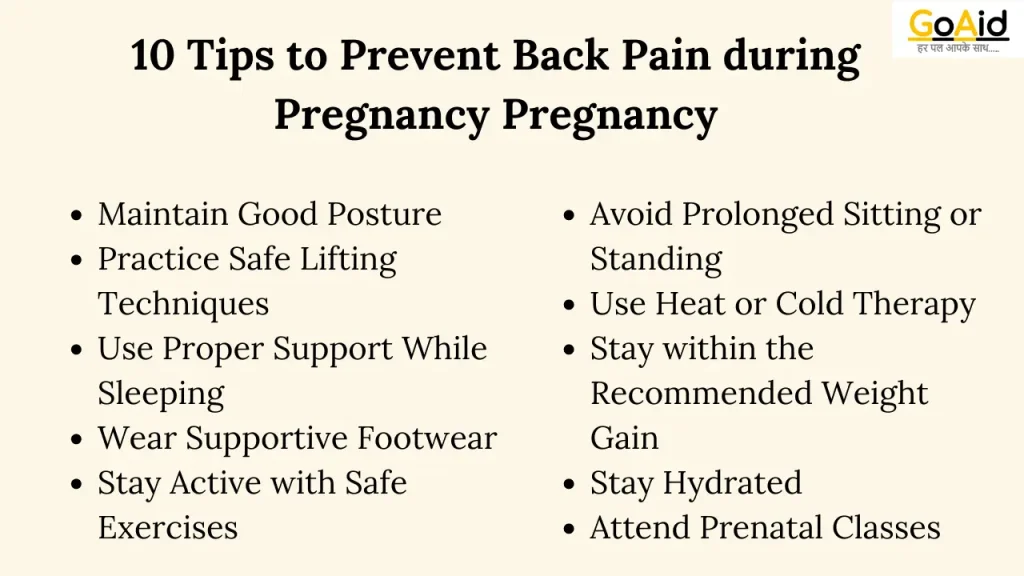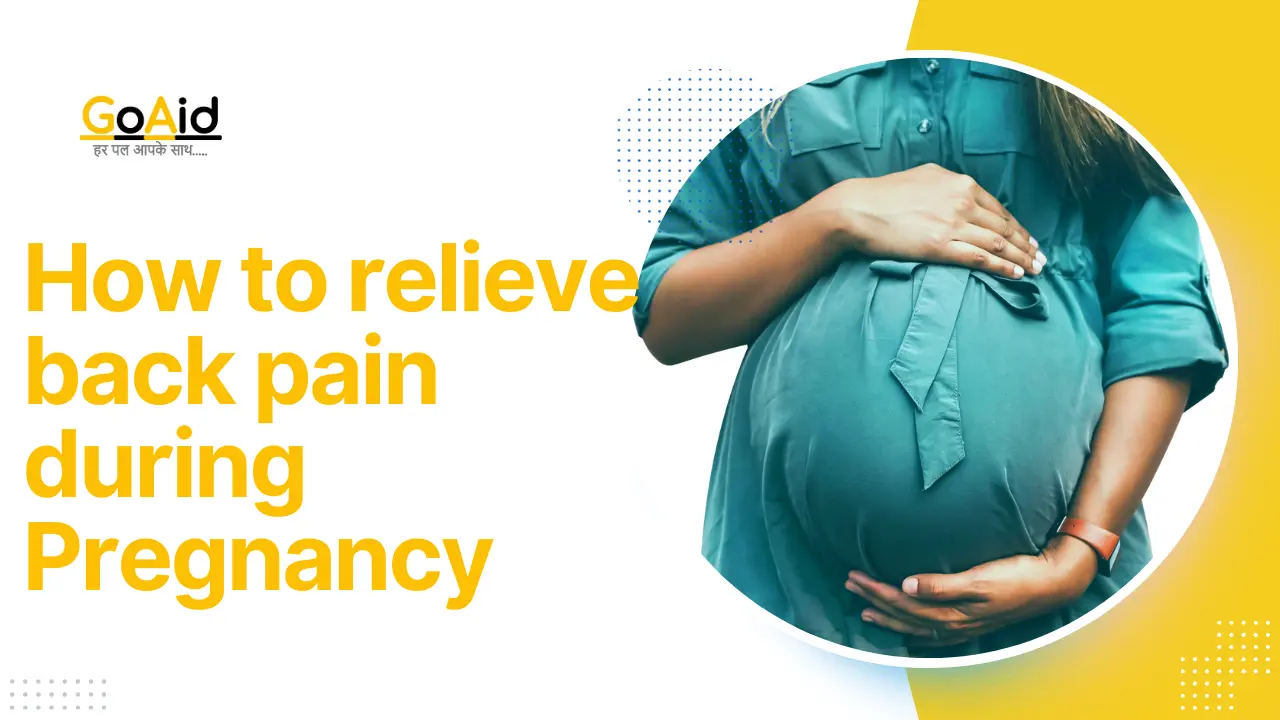Not only in India but in the Entire world, back pain during pregnancy is inevitable. This is why, expecting mothers always look for remedies so they can prevent or reduce Back Pain during Pregnancy.
If you know a woman, who is pregnant, you can confirm with her the severity of the back pain. If you want to feel the back pain, you can tie a towel with 5-10 kg rock/weight on your stomach for at least 10 days. ItŌĆÖs horrible, thatŌĆÖs why its solution is crucial. However, there are some ways through which a woman can reduce this pain to an extent but cannot remove this pain completely until she delivers the baby.
This is why, in this blog, we have added comprehensive details about how women can reduce back pain in pregnancy or prevent back pain in pregnancy, such as the main reason behind the back pain in pregnancy, the best sleeping position, natural and home remedies in India, starches for lower back pain, yoga poses, and much more. If you are also an expecting mother and want to remove or prevent back pain during pregnancy, then read this blog to the end.
So, letŌĆÖs start
The truth about the Back Pain in Pregnancy
Back pain in pregnancy is a common concern for many women, affecting around two-thirds of expectant mothers. This discomfort typically arises due to hormonal changes, weight gain, and the shift in the center of gravity as the baby grows. The increased curvature of the spine to accommodate the growing uterus also contributes to strain on the back muscles and ligaments.
However, it’s important to note that while back pain during pregnancy is prevalent & it varies widely in intensity and duration among pregnant women. For some, it may be mild and occasional, while for others, it can be more persistent and severe. Understanding the factors contributing to back pain during pregnancy, such as posture changes, muscle weakness, and stress, can help in managing and alleviating discomfort effectively.
Implementing strategies like maintaining good posture, gentle exercises approved by healthcare providers, using supportive pillows, and practicing relaxation techniques can significantly reduce back pain. Seeking guidance from healthcare professionals ensures safe and effective management of back pain throughout pregnancy, promoting better maternal comfort and well-being.
Read More: Introduction to Hospital Department List
Main Reason behind the Back Pain during Pregnancy
These are the main reasons behind back pain during pregnancy:
- Weight Gain: The additional weight gained during pregnancy puts stress on the spine and lower back.
- Hormonal Changes: Hormones like relaxin loosen ligaments and joints in preparation for childbirth, affecting spine stability.
- Postural Changes: Shifts in posture to accommodate the growing belly can strain back muscles.
- Center of Gravity: As the uterus expands, the center of gravity shifts forward, altering the body’s balance and increasing strain on the back.
- Muscle Separation: Abdominal muscles stretching to accommodate the baby can weaken core muscles, exacerbating back pain.
- Stress and Tension: Emotional stress and physical fatigue can contribute to muscle tension and exacerbate back discomfort.
- Previous Back Problems: Women with pre-existing back issues may experience increased pain due to pregnancy-related changes.
- Lifestyle Factors: A sedentary lifestyle, improper lifting techniques, and inadequate support during activities can contribute to back pain.
- Poor Posture: Slouching or standing for long periods with poor posture can strain the back muscles and exacerbate discomfort.
- Other Factors: Factors like age, multiple pregnancies, and carrying twins can also contribute to increased back pain during pregnancy.
Best Way to Prevent Back Pain During Pregnancy – Tips to prevent back pain during pregnancy
We have added some of the best ways to prevent back pain during Pregnancy below along with the top 10 tips to prevent back pain in pregnancy:
Best Sleeping Positions for Back Pain when Pregnant
Finding the best sleeping positions during pregnancy is crucial for managing back pain and ensuring comfort. Here are some explained details about recommended sleeping positions:
1. Left Side Sleeping
Sleeping on your left side is often recommended during pregnancy. This position improves circulation to the heart and allows for optimal blood flow to the uterus and kidneys. It also helps reduce pressure on the spine and back muscles.
2. Use of Pillows
Placing a pillow between your knees can help align your hips and reduce strain on your lower back. Additionally, placing a small pillow under your abdomen can provide extra support and alleviate pressure.
3. Avoid Sleeping on Your Back
Sleeping on your back, especially as pregnancy progresses, can cause backaches, hemorrhoids, and even decrease circulation to your heart and your baby. This position can also aggravate back pain.
4. Elevate Your Upper Body
Using pillows to slightly elevate your upper body can help alleviate back pain by reducing pressure on your spine and supporting your upper back and shoulders.
5. Experiment with Body Pillows
Full-body pregnancy pillows can provide support along the entire length of your body. These pillows can help you maintain a comfortable and aligned position throughout the night, reducing strain on your back.
6. Adjusting Bedding
Ensure your mattress is supportive enough to keep your spine aligned. A firmer mattress or mattress topper can provide better support, which is crucial for reducing back pain.
7. Listen to Your Body
As your pregnancy progresses, your body’s needs may change. Listen to your body and adjust your sleeping position as necessary to alleviate discomfort and promote better sleep.
Natural / Home Remedies for Back Pain during Pregnancy
If you are expecting motherhood and looking for home remedies or natural remedies for back pain during pregnancy, then you can choose these natural remedies for back pain during pregnancy:
- Prenatal Yoga: Gentle yoga poses designed for pregnancy can help stretch and strengthen back muscles, promoting flexibility and reducing pain.
- Regular Exercise: Engage in low-impact exercises like walking or swimming to improve muscle tone and reduce strain on the back.
- Heat and Cold Therapy: Apply a heating pad or ice pack to the affected area to alleviate pain and reduce inflammation. Ensure not to apply heat directly to the abdomen.
- Proper Posture: Practice good posture while sitting, standing, and walking to reduce strain on the back muscles. Use a supportive chair and avoid slouching.
- Massage Therapy: Gentle massages from a trained therapist or partner can help relax tense muscles and alleviate back pain.
- Acupuncture: Consider acupuncture sessions with a qualified practitioner to help relieve pain through the insertion of fine needles into specific points on the body.
- Supportive Footwear: Wear comfortable, supportive shoes with low heels to maintain proper posture and reduce strain on the back.
- Pelvic Tilts: Perform pelvic tilts to strengthen abdominal muscles and support the lower back. Lie on your back with your knees bent and gently tilt your pelvis upward.
- Compression Garments: Maternity support belts or abdominal binders can provide support to the abdomen and lower back, reducing discomfort.
- Chiropractic Care: Seek chiropractic adjustments from a practitioner experienced in prenatal care to help align the spine and alleviate back pain.
- Epsom Salt Baths: Soaking in a warm bath with Epsom salts can relax muscles and reduce tension in the back.
- Hydration: Stay hydrated to keep spinal discs lubricated and support overall muscle function, which can reduce the risk of muscle cramps and spasms.
- Gentle Stretching: Incorporate gentle stretches into your daily routine to improve flexibility and alleviate muscle tension in the back.
- Adequate Rest: Ensure you get enough rest and sleep to allow your body to recover and reduce overall stress, which can contribute to back pain.
- Mindfulness and Relaxation Techniques: Practice deep breathing, meditation, or prenatal mindfulness exercises to reduce stress and promote relaxation, which can help alleviate back pain.
Also Read: How To Calculate Pregnancy Weeks?
Yoga poses to relieve Back Pain in Pregnancy
These are the most common Yoga Poses to Relieve Back Pain in Pregnancy:
1. Cat-Cow Pose (Chakravakasana) to relieve back pain in pregnancy
Description: Cat-Cow Pose involves gently arching and rounding the spine, alternating between two poses. It helps alleviate back pain by stretching and releasing tension in the back muscles. This pose also improves flexibility and promotes spinal alignment, making it beneficial throughout pregnancy to maintain mobility and comfort.
How to perform it:
- Start on your hands and knees, aligning wrists under shoulders and knees under hips.
- Inhale, arch your back and lift your tailbone towards the ceiling (Cow Pose).
- Exhale, round your spine, tuck your chin to your chest (Cat Pose).
- Continue flowing between Cow Pose on inhale and Cat Pose on exhale for 5-10 breaths.
- Repeat as needed, coordinating movements with your breath.
Benefits of Cat-Cow Pose in back pain during pregnancy:
- Increases flexibility in the spine and promotes spinal alignment.
- Relieves tension in the lower back and helps alleviate backaches.
- Improves circulation to the spine and surrounding muscles.
- Strengthens and stretches the core muscles, supporting the growing belly.
- Promotes relaxation and reduces stress, beneficial for overall well-being during pregnancy.
2. Child’s Pose (Balasana) to relieve back pain in pregnancy
Description: Child’s Pose is a restorative yoga posture that provides gentle stretching for the back, hips, and thighs. Kneeling and bending forward, resting the forehead on the mat, helps release tension in the lower back and promotes relaxation. This pose is soothing during pregnancy, offering a moment of calm and relief from discomfort.
How to perform it:
- Kneel on the mat, big toes touching, and sit back on your heels.
- Extend your arms forward, lowering your forehead to the mat.
- Rest your arms alongside your body or extend them forward, palms facing down.
- Hold the pose for 5-10 breaths, focusing on deep, steady breathing.
Benefits of Child’s Pose in back pain during pregnancy:
- Stretches and relaxes the spine, reducing tension and discomfort.
- Relieves pressure on the lower back and hips.
- Calms the mind and promotes relaxation, reducing stress levels.
- Helps improve circulation and digestion.
- Provides a gentle stretch for the hips and thighs, which can become tight during pregnancy.
3. Modified Pigeon Pose (Eka Pada Rajakapotasana) to relieve back pain in pregnancy
Description: Modified Pigeon Pose is a hip-opening stretch that targets the hips, groin, and lower back. It involves bringing one knee forward while extending the opposite leg back, easing tension in the hip flexors, and providing relief from sciatic nerve pain common in pregnancy. This pose also prepares the body for labor by opening the pelvic area.
How to perform it:
- Start in a tabletop position, bringing your right knee forward towards your right wrist.
- Extend your left leg back and lower your hips towards the mat.
- Keep your back leg straight or bend it slightly, depending on your comfort.
- Stay upright or lower your upper body towards the mat, resting on your forearms or a pillow.
- Hold the pose for 5-10 breaths, then switch sides.
Benefits of Modified Pigeon Pose in back pain during pregnancy:
- Stretches and releases tension in the hips, groin, and lower back.
- Improves flexibility and range of motion in the hip joints.
- Relieves sciatic nerve pain, common during pregnancy.
- Promotes relaxation and reduces stress levels.
- Prepares the body for labor by opening the hips and pelvis.
4. Standing Forward Bend (Uttanasana) to relieve back pain in pregnancy
Description: Standing Forward Bend is a forward fold that stretches the hamstrings, calves, and back muscles. It helps relieve tension in the lower back and improves circulation throughout the body. This pose promotes relaxation and reduces stress, making it beneficial for pregnant women seeking relief from discomfort and fatigue.
How to perform it:
- Stand with feet hip-width apart, knees slightly bent.
- Inhale, lift your arms overhead and exhale, hinge at the hips to fold forward.
- Rest your hands on your thighs, shins, or the floor, depending on your flexibility.
- Keep your spine long and your neck relaxed.
- Hold the pose for 5-10 breaths, then slowly roll up to standing on an inhale.
Benefits of Standing Forward Bend in back pain during pregnancy:
- Stretches the hamstrings, calves, and back muscles, reducing tension and discomfort.
- Improves circulation to the spine and surrounding muscles.
- Calms the mind and promotes relaxation.
- Relieves sciatic nerve pain and discomfort in the lower back.
- Helps improve digestion and reduce bloating, common during pregnancy.
5. Warrior II Pose (Virabhadrasana II) to relieve back pain in pregnancy
Description: Warrior II Pose strengthens the legs, opens the hips, and stretches the arms and upper back. By grounding through the feet and extending the arms, it promotes stability and balance while relieving tension in the shoulders and back. This pose enhances endurance and prepares the body for the physical demands of childbirth.
How to perform it:
- Start in a standing position with feet wide apart.
- Turn your right foot out 90 degrees and your left foot slightly inward.
- Bend your right knee over your right ankle, keeping your left leg straight.
- Extend your arms parallel to the floor, palms facing down.
- Gaze over your right fingertips and hold the pose for 5-10 breaths.
- Repeat on the other side.
Benefits of Warrior II Pose in back pain during pregnancy:
- Strengthens the legs, promoting stability and balance.
- Opens the hips and stretches the groin and inner thighs.
- Improves circulation and energizes the body.
- Builds endurance and resilience, beneficial for labor and delivery.
- Relieves tension in the arms, shoulders, and upper back.
6. Seated Forward Bend (Paschimottanasana) to relieve back pain in pregnancy
Description: A seated Forward Bend is a seated stretch that lengthens the spine and stretches the hamstrings. By folding forward with a straight back, it releases tension in the lower back and promotes relaxation. This pose also improves digestion and reduces bloating, a common discomfort during pregnancy, while preparing the body for labor by opening the hips and pelvis.
How to perform it:
- Sit on the mat with legs extended in front of you and, your feet flexed.
- Inhale, lengthen your spine and exhale, hinge at the hips to fold forward.
- Reach for your feet, ankles, or shins with your hands, keeping your spine long.
- Relax your neck and shoulders, and hold the pose for 5-10 breaths.
- Slowly release on an inhale and come back to a seated position.
Benefits of Seated Forward Bend in back pain during pregnancy:
- Stretches the spine, hamstrings, and calves, reducing tension and discomfort.
- Calms the mind and promotes relaxation, reducing stress levels.
- Improves digestion and relieves bloating, common during pregnancy.
- Prepares the body for labor by opening the hips and pelvic area.
- Increases flexibility and range of motion in the spine and lower body.
Pregnancy-Safe Stretches for Lower Back Pain
This is a complete set of details about Pregnancy-Safe Straches for Lower back pain:
1. Pelvic Tilt Stretch to Reduce Lower Back Pain During Pregnancy
- Description: Lie on your back with your knees bent and feet flat on the floor. Tighten your abdominal muscles and tilt your pelvis towards your belly button, flattening your back against the floor.
- How to perform it: Hold for 5-10 seconds, then relax. Repeat 10 times, ensuring smooth breathing throughout.
- Benefits: Strengthens abdominal muscles, supports the lower back, and improves posture.
2. Knee-to-Chest Stretch Reduces Lower Back Pain During Pregnancy
- Description: Lie on your back with your knees bent. Bring one knee towards your chest, holding it with both hands. Keep the other leg bent or extended on the floor.
- How to perform it: Hold for 15-30 seconds, then switch legs. Repeat 2-3 times per leg.
- Benefits: Relieves tension in the lower back and stretches the glutes and hips.
3. Cat-Cow Stretch for Reduce the Lower Back Pain During Pregnancy
- Description: Start on your hands and knees, aligning wrists under shoulders and knees under hips. Inhale, arch your back (Cow Pose), and lift your tailbone. Exhale, round your spine (Cat Pose), and tuck your chin to your chest.
- How to perform it: Flow between Cat and Cow Pose for 5-10 breaths, coordinating movement with breath.
- Benefits: Promotes flexibility in the spine, relieves tension in the lower back, and supports core strength.
4. Seated Forward Bend to Reduce the Lower Back Pain During Pregnancy
- Description: Sit on the floor with your legs extended. Inhale, lengthen your spine, exhale, and hinge at the hips to fold forward. Reach for your feet, and shins, or use a strap around your feet.
- How to perform it: Hold for 15-30 seconds, focusing on deep breaths. Repeat 2-3 times.
- Benefits: Stretches the spine, hamstrings, and calves, easing lower back tension and improving circulation.
5. Standing Hamstring Stretch to Reduce the Lower Back Pain During Pregnancy
- Description: Stand with feet hip-width apart. Extend one leg forward with a slight bend in the knee, flex the foot, and hinge forward at the hips until you feel a stretch in the hamstring.
- How to perform it: Hold for 15-30 seconds, then switch legs. Repeat 2-3 times per leg.
- Benefits: Relieves tightness in the hamstrings and lower back, improves flexibility and promotes better posture.
6. Butterfly Stretch for Reduce the Lower Back Pain During Pregnancy
- Description: Sit on the floor with feet together, and knees bent out to the sides. Hold your feet or ankles with your hands. Gently press your knees towards the floor.
- How to perform it: Hold for 15-30 seconds, focusing on relaxing into the stretch. Repeat 2-3 times.
- Benefits: Stretches the inner thighs, hips, and lower back, easing discomfort and promoting relaxation.
Massage Techniques for Back Pain Relief during Pregnancy
There are many types of Massage Techniques that help in the Back Pain Relief During Pregnancy:
1. Swedish Massage for Back Pain Relief in Pregnancy
- Description: Swedish massage involves long, flowing strokes, kneading, and circular movements on superficial layers of muscle using massage oil or lotion. It aims to relax muscles and improve circulation, promoting overall relaxation and pain relief.
- Technique: Begin with gentle effleurage (long, gliding strokes) to warm up the muscles. Use petrissage (kneading) and circular motions to release tension in the back, shoulders, and hips.
- Benefits: Reduces muscle tension, enhances blood flow, improves lymphatic drainage, and alleviates stress and anxiety commonly experienced during pregnancy.
2. Prenatal Massage for Back Pain Relief in Pregnancy
- Description: Prenatal massage is tailored specifically for pregnant women to address their unique physical and emotional needs throughout pregnancy. It incorporates modified techniques and positioning to ensure safety and comfort.
- Technique: Utilize cushions, bolsters, or specialized pregnancy massage tables to support the body in a side-lying or semi-reclined position. Focus on gentle strokes, kneading, and gentle pressure on specific areas of discomfort.
- Benefits: Relieves lower back pain, reduces swelling in the extremities, improves sleep quality, and promotes overall relaxation and well-being for expectant mothers.
3. Trigger Point Therapy for Back Pain Relief in Pregnancy
- Description: Trigger point therapy targets specific areas of muscle tension or “knots” (trigger points) that cause referred pain. Therapists apply sustained pressure to these points to release tension and alleviate pain.
- Technique: Identify tender areas in the back and apply firm pressure with fingertips, thumbs, or elbows. Hold the pressure for 10-30 seconds until the muscle relaxes. Repeat as needed.
- Benefits: Provides relief from localized pain, reduces muscle spasms, improves range of motion, and enhances comfort during pregnancy.
4. Deep Tissue Massage for Back Pain Relief in Pregnancy
- Description: Deep tissue massage focuses on deeper layers of muscle and connective tissue to release chronic tension. Therapists use slow strokes and deep pressure to target specific areas of pain and stiffness.
- Technique: Begin with lighter pressure and gradually increase depth as tolerated by the client. Focus on areas of chronic tension such as the lower back, shoulders, and hips.
- Benefits: Releases chronic muscle tension, improves posture, increases flexibility, and provides long-lasting relief from persistent back pain during pregnancy.
5. Shiatsu Massage for Back Pain Relief in Pregnancy
- Description: Shiatsu is a form of Japanese massage that involves applying rhythmic pressure on specific points along the body’s meridians (energy pathways). It aims to balance the body’s energy flow and promote relaxation.
- Technique: Use thumbs, palms, elbows, or knees to apply pressure on meridian points along the back and other areas. Focus on relieving tension and restoring energy balance.
- Benefits: Alleviates muscle tension, promotes relaxation, improves circulation, balances energy flow, and supports overall well-being during pregnancy.
6. Myofascial Release for Back Pain Relief in Pregnancy
- Description: Myofascial release targets the fascia, the connective tissue that surrounds muscles, to release tension and restore mobility. It involves applying gentle sustained pressure to areas of restriction.
- Technique: Use slow, deliberate strokes with varying pressure to stretch and release the fascia. Focus on areas of tightness and restricted movement in the back and other affected areas.
- Benefits: Improves flexibility, reduces pain and stiffness, enhances range of motion, and promotes better alignment of the body during pregnancy.
7. Acupressure for Back Pain Relief in Pregnancy
- Description: Acupressure involves applying pressure to specific points on the body to stimulate energy flow and relieve pain or discomfort. It is based on traditional Chinese medicine principles.
- Technique: Use thumbs, fingers, or palms to apply firm pressure on acupressure points along meridians related to back pain and pregnancy discomforts.
- Benefits: Alleviates muscle tension, promotes relaxation, reduces stress, enhances circulation, and supports overall health and well-being during pregnancy.
When to see a doctor for Back Pain in Pregnancy?

Back pain in Pregnancy is common and often manageable with self-care measures. However, it’s important to be aware of signs that may indicate a need to consult a doctor:
- Severe or Persistent Pain: If back pain is severe, persistent, or worsening despite rest, stretches, or other remedies, it could indicate a more serious underlying issue.
- Pain Accompanied by Other Symptoms: Seek medical advice if back pain is accompanied by fever, burning sensation during urination, vaginal bleeding, or contractions before 37 weeks, as these could indicate infections, preterm labor, or other complications.
- Pain Radiating Down the Legs: Pain that radiates down the legs, numbness, tingling, or weakness may suggest sciatica or nerve compression, requiring medical evaluation.
- New Onset of Back Pain in Late Pregnancy: If back pain develops suddenly in the later stages of pregnancy, it could indicate conditions like pre-eclampsia or labor starting prematurely.
- History of Back Problems or Pregnancy Complications: Women with pre-existing back issues or a history of pregnancy complications should consult a healthcare provider early on to discuss management and preventive measures.
- Difficulty with Daily Activities: If back pain interferes significantly with daily activities, sleep, or quality of life despite self-care efforts, medical evaluation can guide pain management and relief strategies.
- Concerns about Medication Use: Discuss any concerns about over-the-counter or prescribed medications for back pain relief during pregnancy with a healthcare provider to ensure safety for both mother and baby.
Support Belts or Pillows for Back Pain Relief in Pregnancy
Both support belts and pregnancy pillows are safe and effective methods for managing back pain during pregnancy. Consult with a healthcare provider or a maternity specialist to find the right type and fit for your specific needs. Using these supports along with other self-care measures like gentle exercise, proper posture, and regular stretching can provide comprehensive relief from back pain throughout pregnancy.
1. Usage of the Support Belts in the Back Pain During Pregnancy
- Description: Maternity support belts are specially designed to provide support to the lower back and abdomen during pregnancy. They typically wrap around the lower back and under the belly, offering compression and lifting support.
- How They Work: Support belts help alleviate back pain by reducing the strain on the lower back muscles and supporting the weight of the growing belly. They promote better posture and distribute the weight more evenly, reducing discomfort.
- Benefits: Provides immediate relief from lower back pain, pelvic girdle pain, and sciatica. Supports the abdomen, reduces pressure on the spine, and improves mobility.
- Usage: Wear the support belt snugly but comfortably around the lower back and abdomen. Use it during activities that exacerbate back pain or for prolonged periods when standing or walking.
2. Usage of Pregnancy Pillows in the Back Pain During Pregnancy
- Description: Pregnancy pillows are specially shaped pillows designed to support the body’s contours and alleviate discomfort during pregnancy. They come in various shapes, including full-body pillows, wedge pillows, and smaller support pillows.
- Types:
- Full-body pillows: Support the entire body, providing support between the knees, under the belly, and behind the back.
- Wedge pillows: Provide targeted support under the belly or behind the back while sitting or lying down.
- Support pillows: Small pillows designed to support specific areas like the lumbar region or between the knees.
- How They Work: Pregnancy pillows help reduce back pain by providing cushioning and support to relieve pressure points. They promote better spinal alignment, improve sleep quality, and alleviate discomfort associated with pregnancy.
- Benefits: Enhances comfort during sleep and rest, and reduces strain on the back, hips, and pelvis. Supports proper posture and alignment, which can reduce back pain and improve overall well-being.
- Usage: Place the pregnancy pillow strategically to support areas of discomfort, such as under the belly, between the knees while side sleeping, or behind the back while sitting or reclining.
Best Ambulance to Use during Pregnancy
Choosing the best ambulance service during pregnancy is crucial for ensuring safety and comfort. GoAid Ambulance Service for Pregnant Women stands out as an excellent choice, especially for expecting mothers. HereŌĆÖs why:
GoAid Ambulance Service offers specialized care tailored to the needs of pregnant women. They provide free private ambulance services for expecting mothers, ensuring prompt and safe transportation during emergencies or routine medical visits.
One unique benefit is their exclusive offer: if a pregnant woman delivers a girl child in the hospital after using GoAidŌĆÖs ambulance service, the parents receive 100% cashback instantly. This commitment to maternal care and financial support makes the GoAid Ambulance Service a reliable and compassionate option for pregnant women in need of emergency medical transport.
Top 10 Tips to Prevent Back Pain during Pregnancy

These are the top 10 tips to prevent back pain during pregnancy:
1. Maintain Good Posture
Proper posture is crucial during pregnancy to minimize strain on your back. Stand upright with your shoulders back, pelvis tucked in, and weight evenly distributed on both feet. Avoid arching your back excessively or slouching, as these positions can strain muscles and ligaments.
2. Practice Safe Lifting Techniques
For lifting objects, bend your knees instead of your waist to engage your leg muscles. Keep the object close to your body as you lift, and avoid twisting motions. This technique reduces strain on your lower back and decreases the risk of injury.
3. Use Proper Support While Sleeping
Sleep on your side with your knees bent and a pillow placed between your legs. This position helps align your hips and reduces pressure on your lower back. Choose a supportive mattress and pillows to maintain spinal alignment and enhance comfort.
4. Wear Supportive Footwear
Opt for comfortable shoes with good arch support and cushioning. Proper footwear helps distribute your body weight evenly, reducing strain on your back and feet. Avoid high heels or shoes with inadequate support, which can exacerbate back pain.
5. Stay Active with Safe Exercises
Engage in low-impact exercises approved by your healthcare provider, such as swimming, walking, or prenatal yoga. These activities strengthen muscles, improve flexibility, and support your back without placing excessive strain on your body.
6. Avoid Prolonged Sitting or Standing
Alternate between sitting and standing positions throughout the day to prevent stiffness and alleviate pressure on your spine. Take breaks to walk and stretch regularly, especially if you have a desk job or spend extended periods on your feet.
7. Use Heat or Cold Therapy
Apply a heating pad or cold pack to the affected area for 15-20 minutes as needed. Heat therapy helps relax muscles and increase blood flow, while cold therapy reduces inflammation and numbs painful areas. Always wrap the heat or cold source in a cloth to protect your skin.
8. Stay within the Recommended Weight Gain
Follow your healthcare provider’s guidelines for healthy weight gain during pregnancy. Excess weight can strain your back and increase discomfort. Eat a balanced diet rich in nutrients to support your baby’s growth and maintain a healthy weight.
9. Stay Hydrated
Drink plenty of water throughout the day to keep your spinal discs hydrated and maintain their cushioning effect. Proper hydration supports overall spine health and reduces the risk of back pain associated with dehydration.
10. Attend Prenatal Classes
Enroll in prenatal classes that focus on proper body mechanics, relaxation techniques, and exercises tailored for pregnancy. These classes teach you how to protect your back during daily activities and prepare for childbirth, promoting a more comfortable pregnancy journey.
Conclusion
In Conclusion, managing back pain during pregnancy is essential for ensuring comfort and maintaining overall well-being. By incorporating safe practices such as maintaining good posture, practicing safe lifting techniques, using supportive pillows, and engaging in prenatal exercises, you can effectively alleviate discomfort.
Additionally, natural remedies like heat or cold therapy, prenatal massage, and yoga can provide further relief. Understanding the best sleeping positions and when to seek medical advice are also crucial aspects of managing back pain during pregnancy.
Throughout this blog, we have covered comprehensive tips and techniques to relieve and prevent back pain during pregnancy. From safe exercises to pregnancy-safe stretches, and from supportive belts to massage techniques, these strategies are designed to support you through this transformative journey.
Remember, every pregnancy is unique, so it’s important to consult with your healthcare provider before starting any new regimen. If you have any questions or need further guidance, feel free to ask in the comment section below. Your comfort and health are our priority.
Read More: Some Important Topics
FAQs about How to Relieve Back Pain during Pregnancy
Back pain is a prevalent issue during pregnancy, affecting approximately 50-70% of expectant mothers at some point. It often arises due to hormonal changes that loosen ligaments and joints, weight gain altering the body’s center of gravity, and the strain of carrying the growing baby.
Back pain in pregnancy is primarily caused by physiological changes such as hormonal shifts that relax ligaments and joints, leading to instability and strain. Additional factors include weight gain, postural adjustments to accommodate the growing belly, and increased stress on the spine and muscles.
Effective strategies include maintaining proper posture to reduce strain on the back, using supportive pillows for sleep, engaging in gentle exercises like swimming or prenatal yoga to strengthen muscles, and seeking prenatal massage therapy to alleviate tension and improve circulation.
Preventive measures include maintaining a healthy weight with regular exercise approved by your healthcare provider, practicing correct lifting techniques (bending at the knees and avoiding twisting), using supportive footwear, and taking breaks from prolonged standing or sitting to reduce strain on the back.
Safe exercises for back pain relief include low-impact activities like walking, swimming, and prenatal yoga. These exercises strengthen core muscles, improve flexibility, and promote better posture, all of which can help alleviate back discomfort.
Yes, prenatal yoga is beneficial for reducing back pain as it focuses on gentle stretches, breathing techniques, and relaxation exercises that help strengthen muscles, improve flexibility, and alleviate tension in the back and pelvis.
Sleeping on your side with knees bent and a pillow placed between your legs can help maintain spinal alignment and relieve pressure on the lower back. This position supports the natural curve of the spine and reduces discomfort caused by increased weight and shifting posture during pregnancy.
Natural remedies such as applying heat or cold packs to the affected area, receiving prenatal massages from qualified therapists, practicing gentle stretching exercises, and maintaining adequate hydration can effectively manage and reduce back pain during pregnancy.
Support belts and pillows provide additional support to the abdomen and lower back, reducing strain on muscles and ligaments. They help distribute the weight of the growing belly more evenly, improve posture, and alleviate discomfort associated with back pain during pregnancy.
Massage therapy can be beneficial throughout pregnancy, especially during the second and third trimesters when back pain tends to increase. It helps relax muscles, improve circulation, and reduce tension in the back, promoting overall comfort and well-being.
Pregnancy-safe stretches include gentle exercises such as cat-cow stretch, pelvic tilts, and kneeling hip flexor stretch. These stretches help strengthen core muscles, improve flexibility, and alleviate lower back pain without causing strain or discomfort.
Yes, it is common to experience back pain at various stages of pregnancy. Hormonal changes, weight gain, and the physical demands of carrying a growing baby can contribute to discomfort in the back, particularly in the lower back and pelvic region.
Staying well-hydrated is essential for maintaining spinal disc elasticity and joint lubrication. Adequate hydration helps prevent muscle cramps, supports the body’s natural cushioning system, and reduces the risk of back pain associated with dehydration or muscle tension.















